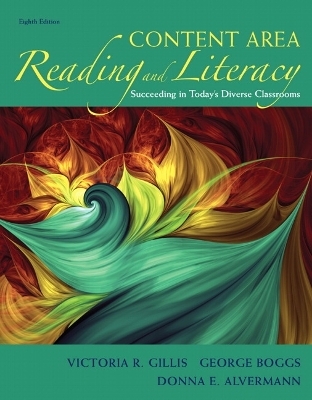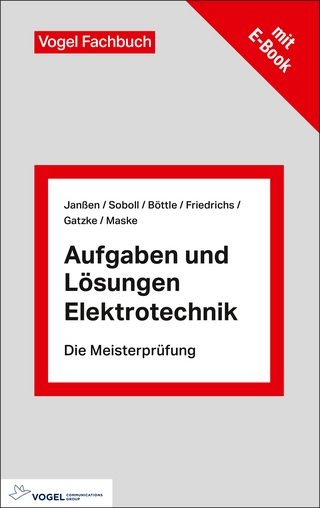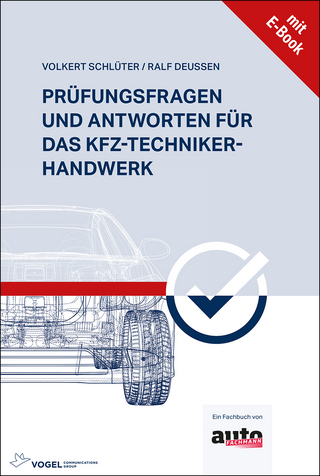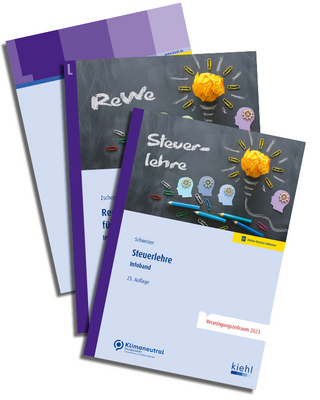
Content Area Reading and Literacy
Pearson
978-0-13-384654-6 (ISBN)
- Titel ist leider vergriffen;
keine Neuauflage - Artikel merken
A focus on learning content through discipline-appropriate literacy practices, a strong emphasis on writing, and a current look at the use of media in teaching are hallmarks of the new edition of this widely popular text. Throughout, middle and secondary school teachers get a readable presentation of discipline-appropriate literacy practices and examples and adaptions of selected strategies. Set up to ensure comprehension, the chapters link to the Learning Cycle presented in the beginning of the book, graphic organizers help readers navigate chapter content, and questions, summaries, vignettes, and examples make the concepts clear. This edition of Content Area Reading and Literacy features three full chapters focusing on writing instruction, integrates culture and diversity throughout, and expands or reemphasizes important topics, such as life-long readers and learners beyond the printed text, close and critical reading in discipline-appropriate ways, evidence-based writing, and multimodal texts.
0133846547 / 9780133846546 Content Area Reading and Literacy: Succeeding in Today's Diverse Classrooms, Pearson eText with Loose-Leaf Version -- Access Card Package
Package consists of:
0134228340 / 9780134228341 Content Area Reading and Literacy: Succeeding in Today's Diverse Classrooms, Pearson eText -- Access Card
013425645X / 9780134256450 Content Area Reading and Literacy: Succeeding in Today's Diverse Classrooms, Loose-Leaf Version
Victoria R. Gillis graduated from North Georgia College with a BS degree in Biology and from Emory University with an MAT in Secondary Science Education. She taught middle and high school science courses including life science, chemistry, physics, and physical science in Georgia, Florida, and South Carolina for 20 years. In the early 1970s, she encountered the ideas and concepts in what was known as content area reading and tried them in her classroom. Her success in using principles of active learning drawn from content area reading led her to return to graduate school to complete a PhD at the University of Georgia in 1994. Victoria taught graduate and undergraduate disciplinary literacy courses at Clemson University for 20 years and served as a volunteer in the Reading and Writing for Critical Thinking project in Eastern Europe and Central America at the turn of the century. She is currently Wyoming Excellence in Education Literacy Chair in the College of Education at the University of Wyoming. George L. Boggs graduated from King College with a B.A. in English/Literature and Religion before beginning his career as a teacher and coach in the Pacific Northwest. He taught middle school language arts, Latin, Spanish, and technology before returning to graduate school for a MA in Classics from Durham University in Great Britain. Graduate study in a different educational system in an entirely new field helped clarify a lifelong interest in disciplinary literacies. Returning to high school teaching in Georgia, he sought opportunities to help students make sense of the specialized ways of thinking that define school content areas, first, but also workplace and other domains that matter to children. This work culminated in doctoral research at the University of Georgia completed in 2012. His role as literacy researcher and teacher educator has positioned him at Florida State University to develop opportunities for teachers to understand the role of literacy in their subject area goals. Donna Alvermann is the University of Georgia Appointed Distinguished Research Professor of Language and Literacy Education. She also holds an endowed chair position: The Omer Clyde and Elizabeth Parr Aderhold Professor in Education. Formerly a classroom teacher in Texas and New York, her research focuses on young people’s digital literacies and use of popular media. Author of numerous articles, she has several books to her credit: Adolescents and Literacies in a Digital World; Reconceptualizing the Literacies in Adolescents’ Lives (3rd ed.); Adolescents’ Online Literacies: Connecting Classrooms, Digital Media, and Popular Culture; and Bring It to Class: Unpacking Pop Culture in Literacy Learning. Most recently, she helped in designing an interactive website to learn how a community of researchers and researched objects can push boundaries associated with creating and disseminating “original” work and remixes online using a Creative Commons license.
Brief Table of Contents
Chapter 1 Content Literacy and the Reading Process - 1
Chapter 2 Creating Effective Learning Environments - 34
Chapter 3 Planning for Content Literacy - 58
Chapter 4 Assessment of Students and Textbooks - 89
Chapter 5 Preparing to Read - 123
Chapter 6 Reading to Learn - 143
Chapter 7 Increasing Vocabulary and Conceptual Growth - 177
Chapter 8 Reflecting on Reading and Learning - 215
Chapter 9 Teaching Writing - 239
Chapter 10 Writing to Learn - 254
Chapter 11 Writing to Inquire - 279
Chapter 12 Developing Lifetime Readers: Literature in Content Area Classes - 296
Detailed Table of Contents
Preface xv
Chapter 1 Content Literacy and the Reading Process 1
Assumptions Underlying Content Teaching 4
Subject Matter 4
Role of the Textbook 5
Active and Independent Readers 6
Fluent Readers 8
Fluency with Information Technology 8
What It Means to Be Literate 9
Literate Thinking 10
Content Literacy 11
Disciplinary Literacy 12
The New Literacy Studies 19
The Reading Process 21
A Cognitive View 21
A Social Constructionist Perspective 26
The Role of Motivation 29
Summary 32
Suggested Readings 32
Chapter 2 Creating Effective Learning Environments 34
Affective Characteristics 37
Linking Content Literacy with Students' Lives 37
Adaptive Instruction 41
Providing Choices 42
Language as a Vehicle for Teaching and Learning Content 42
Seeing Language as a Social Practice 43
Dealing with Gendered Language in the Classroom and the Text 44
Diversity in Language and Learning 46
Second-Language Acquisition and Learning 46
Struggling or Reluctant Readers 50
Gifted and Talented Learners 51
Teaching and Learning in Culturally Diverse Classrooms 53
Today's Globalizing Influences 53
Supporting Literacy among Adolescent English Learners 55
Summary 56
Suggested Readings 57
Chapter 3 Planning for Content Literacy 58
Instructional Decision Making 61
Essential Questions and Content Objectives 62
Language and Disciplinary Literacy Objectives 65
Learning Materials 66
Student Capabilities and Needs 66
Evaluation and Assessment 68
Planning and Educational Technology 69
Teaching Resources on the Web 70
Planning Student Involvement with the Internet 72
Planning for New Literacies 74
Structured Frameworks for Content Literacy Lessons 75
The Learning Cycle 75
Reciprocal Teaching 78
Reading and Writing Workshops 80
Beyond the Daily Plan 80
Unit Planning 81
Schoolwide Programs 82
Interdisciplinary Teaching 84
Thematic Teaching 86
Summary 87
Suggested Readings 87
Chapter 4 Assessment of Students and Textbooks 89
Assessing Students 92
Tests and Testing: A Consumer Advisory 92
Types of Assessment 95
Purposes of Assessment: Learning about Students 101
Assessment for Learning: Cognitive Domain 102
Assessment for Learning: Affective Domain 108
Assessment of Learning: Grades and Grading 112
Assessment as Learning: Portfolio Assessment 114
Assessing Textbooks 119
Readability Formulas 120
Consumer Judgments (or Don't Judge a Book by Its Cover) 121
Summary 122
Suggested Readings 122
Chapter 5 Preparing to Read 123
The Role of Prior Knowledge 126
Hurdles to New Learning 126
The Teacher's Task 127
Assessing and Building Prior Knowledge 128
The List-Group-Label Strategy 129
Graphic Organizers 130
Reading, Viewing, and Listening 131
Writing 132
Activating Prior Knowledge with Prereading Strategies 133
Anticipation Guides 134
Problem-Solving Activities 139
K-W-L 140
Summary 142
Suggested Readings 142
Chapter 6 Reading to Learn 143
Constructing Meaning with Text 146
Disciplinary Differences in Constructing Meaning 147
Discipline-Specific Literacy Practices 148
Helping Students Comprehend 150
Teaching Students to Be Strategic 150
Making Text Comprehensible 152
The Role of Fluency in Comprehension 152
Close Reading 155
Questions and Questioning 156
When to Ask: The Right Time and the Right Place 157
What to Ask: The Relation between Questions and Answers 157
How to Ask: Questioning Strategies 163
Text Structure and Complexity 167
Common Text Structures 167
Teaching about Text Structures 168
Text Complexity 172
Comprehending Online Texts 174
Summary 175
Suggested Readings 176
Chapter 7 Increasing Vocabulary and Conceptual Growth 177
Learning Words and Concepts 180
How Students Learn Vocabulary 181
Word-Learning Tasks 181
Levels of Word Knowledge 182
Types of Vocabulary 182
Discipline-Specific Vocabulary Characteristics 183
Readers' Resources for Learning New Words 185
Teaching Vocabulary: Preactive Phase 188
Criteria for Selecting Vocabulary 190
Guidelines for Vocabulary Instruction 190
Strategies for Introducing and Teaching Vocabulary:
Preactive/Interactive Phase 191
Developing Students' Independence: Interactive Phase 197
Using Context Clues 197
Using Familiar Word Parts 199
Using Dictionaries 201
Vocabulary Self-Collection 201
Intensive Approaches for Struggling Readers and English Learners 203
Reinforcing Vocabulary: Reflective Phase 206
Literal-Level Activities 207
Interpretive-Level Activities 207
Application-Level Activities 212
Summary 213
Suggested Readings 214
Chapter 8 Reflecting on Reading and Learning 215
Engaging Students through Discussion 218
Small-Group Discussions 218
Peer-Led Literature/Learning Circles 220
Cooperative/Collaborative Learning 222
Cross-Age Tutoring 222
Guiding Student Reflection 224
Reaction Guides 224
Reading, Viewing, Listening, or Acting for Different
Purposes 226
Discussion Webs 227
Intra-Act Procedure 229
General Discussion Techniques 231
Promoting Critical Literacy 231
Teaching Literacy for Critical Awareness 233
Incorporating Critical Media Literacy into the Curriculum 234
Summary 238
Suggested Readings 238
Chapter 9 Teaching Writing 239
Writing Activities for Content Areas 242
Authentic Writing 242
Simulations 243
Writing Assignments 244
Writing as a Process 244
Reviewing and Summarizing 245
Understanding Writing as a Part of Development 248
From Pointing to Writing 248
Reading Is Writing Is Analysis 248
Responding to Student Writing 249
Peer Responses 249
Teacher Conferences 251
Formal Evaluation 251
Summary 252
Suggested Readings 253
Chapter 10 Writing to Learn 254
Note-Making Strategies 257
Strategies That Foster Discipline-Appropriate Thinking 261
Structured Note Making 261
Learning Logs and Journals 263
Think Writes 267
Response Heuristic 268
Creative Writing to Learn 270
Cinquains 270
Biopoems 271
Found Poems 271
Raft Assignments 273
Other Creative Writing Activities 275
Summary 277
Suggested Readings 278
Chapter 11 Writing to Inquire 279
Understanding Writing in Context 282
Academic Literacies 283
Disciplinary Literacies 283
21st-Century Literacies 283
Preparing for Student Inquiry 285
Collecting and Organizing Information 286
Research or Three-Search? 286
I-Charts 287
Writing a Report 288
Outlining 288
Paraphrasing 289
Revising 289
Alternatives to the Traditional Research Report 290
Multigenre Reports 290
Information Literacy and Library Skills 291
Website Evaluation 292
Hypermedia 293
Collaborative Internet Projects 294
Summary 295
Suggested Readings 295
Chapter 12 Developing Lifetime Readers: Literature in Content Area Classes 296
Reading among Adolescents 299
Who's Reading What? 299
Reading in the Digital Age 300
Reading Practices in the Content Areas 300
Benefits of Moving beyond the Textbook 300
Encouraging Responses to Literature 301
Integrating Literature into Content Areas 302
Uses of Literature in Content Areas 302
Fiction and Nonfiction for Content Areas 307
Developing Awareness of Diversity through Texts 311
Advantages of Using Multicultural Literature 312
Resistance to Multicultural Literature 312
Choosing and Using Multicultural Literature 314
Summary 317
Suggested Readings 317
Appendix A Word Lover's Booklist 319
Appendix B Read-Aloud Books for Content Areas 320
Appendix C Trade Books for Science, Math, and Social Studies 322
Appendix D Culturally Conscious Trade Books 326
Appendix E Standards for the Content Areas-Web Ready/At a Glance 330
References
Name Index
Subject Index
| Erscheint lt. Verlag | 5.8.2016 |
|---|---|
| Sprache | englisch |
| Maße | 216 x 274 mm |
| Gewicht | 658 g |
| Themenwelt | Schulbuch / Wörterbuch |
| Sozialwissenschaften ► Pädagogik ► Berufspädagogik | |
| Sozialwissenschaften ► Pädagogik ► Schulpädagogik / Sekundarstufe I+II | |
| ISBN-10 | 0-13-384654-7 / 0133846547 |
| ISBN-13 | 978-0-13-384654-6 / 9780133846546 |
| Zustand | Neuware |
| Haben Sie eine Frage zum Produkt? |
aus dem Bereich


